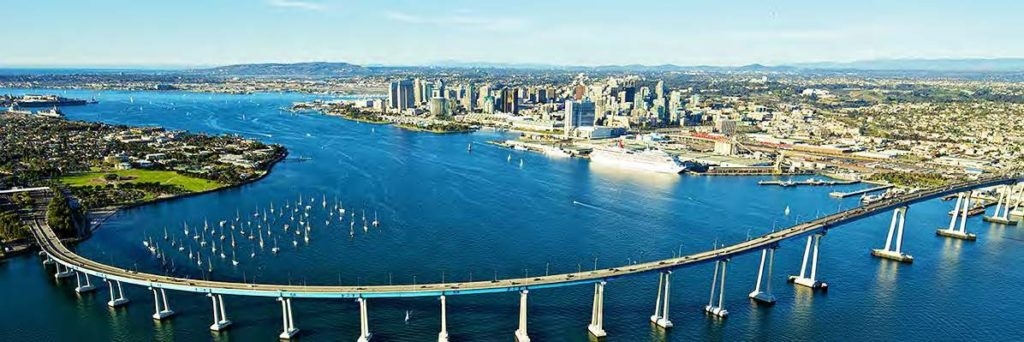Final Report on Regional Economic Vulnerability to Sea Level Rise in San Diego

One of the consequences of climate change and sea level rise that has not been extensively examined is potential damage to regional economies. Most studies have focused on possible damages to individual properties, but looking at future flood risks in future dollars at the regional economic level is a new approach.
The San Diego Regional Climate Collaborative engaged the Center for the Blue Economy of the Middlebury Institute of International Studies to investigate the potential effects from climate change and projected sea level rise and coastal storms on the economy of San Diego County. The stakes are high, as San Diego County is the 17th largest metropolitan area in the country and the 5th largest in California. San Diego County has a Gross Domestic Product (GDP) that is larger than 25 other U.S. states.
Using sea level rise and storm scenarios that are estimated by the U.S. Geological Survey’s Coastal Storms Modeling Systems, the Center for the Blue Economy estimated the economic impacts of flooding for three scenarios and two time periods. The scenarios focused on: a) reductions in employment, output, and income that directly and indirectly result from a single major flooding event, and b) an assessment of how the economy may evolve over time given repetitive flooding. The findings offer detailed analysis of economic vulnerability by industry, by city, and for the county as a whole and details possibilities for GDP, employment, sales, individual properties, and Port vulnerabilities.
Under the highest sea level scenario with the most severe storm (2 meters sea level rise and a 1% or 100-Year Storm) over 2,600 establishments with 49,000 jobs, $8.0 billion in sales, and $6.1 billion in contribution to the gross domestic product in San Diego County are vulnerable to flooding. Under this same scenario, $2.2 billion to $2.6 billion in buildings and equipment on property classified as commercial or industrial is at risk of damage. These estimates assume that maximum flood depth affects all establishments.
“It is important to make the point that all the figures presented in the report are not forecasts of specific impacts, but are indicators of the scale of possible vulnerabilities in the future,” says study author Dr. Charles Colgan, Director of Research at the Center for the Blue Economy. “The study presents evidence that there are significant risks to the San Diego regional economy from climate change and sea level rise, but the analysis presents only a partial picture of the nature of those risks. Trying to estimate storms and their effects years or decades in the future is not possible.” All that can be done at this stage, according to the report, is to note the factors that may increase the frequency and intensity of storms and to couple those with expectations about factors determining sea level rise:
⋅The rate and extent of climate change, which itself will largely be determined by the extent and effectiveness of global efforts to dramatically reduce the emissions of greenhouse gases into the atmosphere.
⋅The extent of sea level rise associated with climate change. The rate at which the oceans warm (and thus expand) as well as the rates of ice melt in major glacial systems such as Greenland and Antarctica as well as the extent of runoff of precipitation from rainfall over both oceans and land.
⋅Climate change will also change the intensity and, especially, the frequency of storm events. Larger storms will become more frequent; the 100-year storm will occur more frequently. These storms, which have historically had a 1% chance of occurring in one year, will increase the chance of occurring to as much as a 10% chance of occurring with higher levels of climate change. Storms that occur once a year may occur twice or even more per year.
This combination of factors suggests that the annual risks of flooding are likely to be higher than presented in the Center for the Blue Economy report, which is based on historical patterns shaped by a different climate than the one likely to exist in the future. “The individual event risks analyzed here,” says Dr. Colgan in the study, “will be less important than the cumulative risks over time. The question for businesses at risk, particularly in the tourism and recreation sectors, will be how they can sustain economic success in the face of repeated and increasingly severe disruptions in their business.”
Parts of San Diego County are already planning for precautionary measures to mitigate damage related to sea level rise and flooding. The Center for the Blue Economy study of regional economic vulnerability is part of a larger effort regionally known as “The Resilient Coastlines Project,” a recently completed project that supported more than 14 local sea level rise initiatives in the San Diego region. The San Diego Climate Collaborative launched the project in 2015 with almost $700 thousand dollars of support from the National Oceanic and Atmospheric Administration Regional Coastal Resilience Program. The project coordinated efforts to galvanize local leadership, develop legal and economic tools to plan and respond to flooding events, enhance natural infrastructure to protect from the effects of flooding and sea level rise, and to engage the community through public awareness campaigns incorporating storytelling, art, and music.
“The Resilient Coastlines Project provided us with tools we need to move forward with sea level rise planning as a city,” says Amanda Lee, Senior Planner at the City of Del Mar. “The project was really valuable in helping us clarify that the choice of no action is the most costly option for our city moving forward. We are in a much better position now to communicate this reality.”
